- Details
- Written by: Elmazen
- Category: Flags of Countries of the World
- Hits: 795
Flag of Monaco, Currency, Population, Tourist Places
Flag of Monaco, Currency, Population, Tourist Places, Borders, Culture
Monaco: A Jewel on the French Riviera
Monaco, a small yet glittering principality nestled on the Mediterranean coast, has long been associated with luxury, glamour, and scenic beauty.
Though it is the second-smallest country in the world, Monaco’s unique charm draws tourists and global elites alike.
Here’s an in-depth look at this fascinating country, covering everything from its population to its rich culture.
Flag of Monaco, Currency, Population, Tourist Places
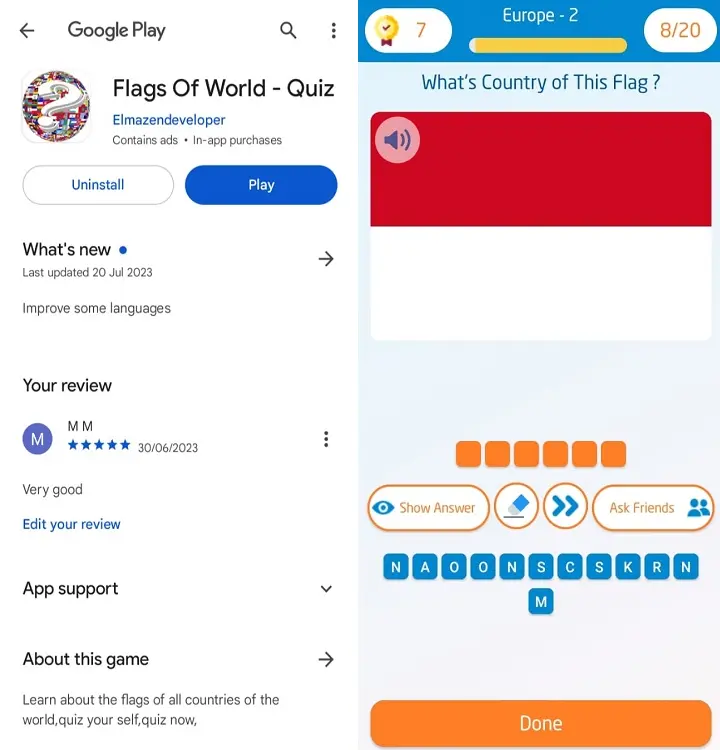
Download the application  Flags Of World - Quiz ,
Flags Of World - Quiz ,
And test your knowledge with Flags of World ,
1. Population of Monaco :
Monaco has a population as of December 2024 around 38,500 people, making it one of the most densely populated countries in the world.
Despite its tiny size-just about 2.02 square kilometers - Monaco is a diverse, multicultural hub, with nearly 80% of its residents being expatriates.
The largest groups of foreign nationals include French, Italian, and British citizens.
Monegasques (native Monégasque people) make up about 22% of the population.
The official language is French, though Italian and English are widely spoken due to Monaco's international appeal.
2. Monaco’s Country Flag Meaning :
The flag of Monaco consists of two horizontal bands of red (top) and white (bottom).
This simple yet bold design is one of the oldest flags in the world, dating back to 1297, when the House of Grimaldi first took control of Monaco.
The red and white colors are those of the Grimaldi family and have no specific symbolism attached to them other than representing the ruling family.
Monaco's flag closely resembles that of Indonesia but differs in proportions.
3. Currency of Monaco :
Monaco’s official currency is the Euro (€), even though it is not part of the European Union.
This is because of a special agreement with France, which handles Monaco's currency issues.
Prior to adopting the Euro, Monaco used the Monegasque franc.
Despite being an independent principality, Monaco has maintained close economic ties with France, which is reflected in their shared currency.
Flag of Monaco, Currency, Population, Tourist Places

Download the application  Flags Of World - Quiz ,
Flags Of World - Quiz ,
And test your knowledge with Flags of World ,
4. Monaco’s Borders :
Monaco is located on the French Riviera, bordering France on three sides and the Mediterranean Sea on the other.
It shares a 5.47-kilometer land border with France, with the nearest major city being Nice, located about 13 kilometers to the west.
Monaco is also a short distance from Italy, which lies roughly 16 kilometers to the east.
Despite its small landmass, Monaco is one of the wealthiest countries in the world and plays a strategic role in the region.
5. Culture of Monaco :
Monaco is a blend of French, Italian, and Mediterranean influences, shaped by its royal heritage and high-society atmosphere.
The principality is known for its opulence, with its world-famous Monte Carlo Casino being a symbol of luxury.
Monaco’s royal family, the House of Grimaldi, also plays a significant role in the country’s cultural identity, with events like the Monaco Grand Prix and the Monte Carlo Rally becoming international symbols of prestige and high living.
Monaco's cultural life revolves around the arts, particularly ballet, opera, and classical music.
The Monte Carlo Philharmonic Orchestra and the Ballets de Monte-Carlo are two prominent cultural institutions that attract global audiences.
Additionally, the country’s National Day (November 19) is celebrated with great pomp and circumstance, featuring parades, concerts, and fireworks.
Though Monaco is famous for its high-end lifestyle, it maintains a distinct sense of tradition.
The Monégasque people celebrate their roots with a strong focus on family, religious holidays, and time-honored customs.
6. Best Places to Visit in Monaco :
Despite its small size, Monaco is packed with beautiful attractions that reflect its history, culture, and love for the finer things in life.
Here are some of the best places to visit:
Monte Carlo Casino :
Perhaps the most iconic spot in Monaco, the Monte Carlo Casino is a must-see for those interested in architecture, history, or simply the glamorous lifestyle that Monaco epitomizes.
Prince’s Palace of Monaco :
Home to the ruling Grimaldi family, this palace dates back to the 12th century.
Visitors can tour the state apartments and enjoy breathtaking views over Monaco from its hilltop location.
Oceanographic Museum :
Founded by Prince Albert I in 1910, this museum is one of the oldest aquariums in the world and showcases fascinating marine life from the Mediterranean and beyond.
Monaco Cathedral :
This Roman-Byzantine style cathedral houses the tombs of past Monégasque princes, including the famous Grace Kelly, who became Princess Grace of Monaco after marrying Prince Rainier III.
Monaco Grand Prix Circuit :
Fans of Formula 1 should not miss a walk along the famous Monaco Grand Prix street circuit, considered one of the most challenging and prestigious tracks in motorsport.
Larvotto Beach :
If you're looking for some relaxation, Monaco’s public beach, Larvotto, offers a rare sandy spot to unwind by the sea, along with some fantastic views.
Exotic Garden (Jardin Exotique):
This garden showcases an array of cacti and succulents from all over the world, perched on the cliffs with stunning views of the sea and Monaco below.
Conclusion :
Monaco may be small in size, but it is brimming with culture, history, and luxurious charm.
Whether you are drawn to its royal history, upscale attractions, or the stunning Mediterranean landscapes, Monaco offers an unforgettable experience for visitors.
From the grandeur of the Monte Carlo Casino to the serenity of the Monaco Cathedral, there is something for everyone to enjoy in this glittering principality.
Flag of Monaco, Currency, Population, Tourist Places

Download the application  Flags Of World - Quiz ,
Flags Of World - Quiz ,
And test your knowledge with Flags of World ,
- Details
- Written by: Elmazen
- Category: Flags of Countries of the World
- Hits: 855
Flag of Moldova, Currency, Population, Tourist Places
Moldova: A Guide to Population, Flag, Currency, Borders, Culture, and Top Tourist Attractions
Moldova is a small country in Eastern Europe that is rich in culture and history, yet relatively unknown to many travelers.
It has a unique charm and a blend of influences from neighboring countries.
In this article, we will explore six key aspects of Moldova: its population, flag meaning, currency, borders, culture, and top places to visit.
Flag of Moldova, Currency, Population, Tourist Places
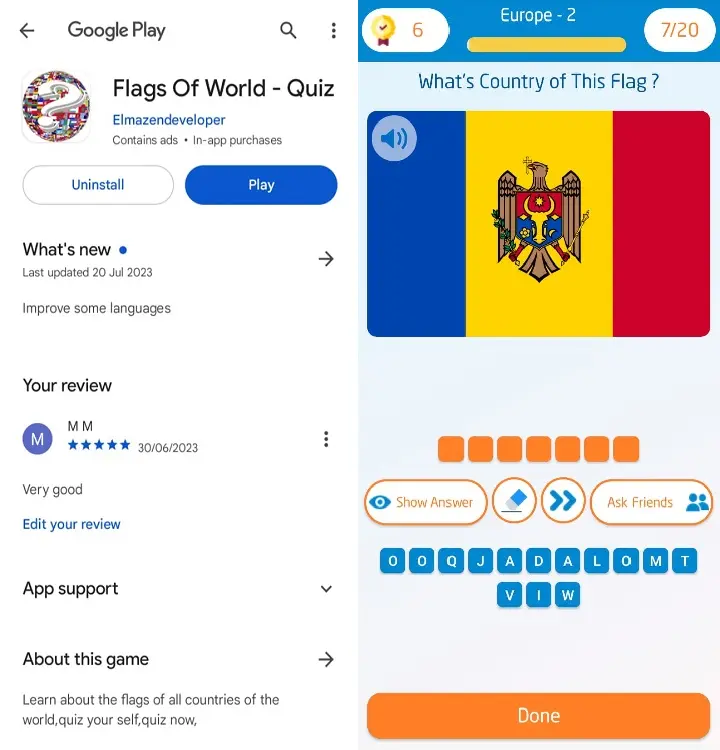
Download the application  Flags Of World - Quiz ,
Flags Of World - Quiz ,
And test your knowledge with Flags of World ,
1. Population of Moldova :
As of December 2024, Moldova has a population of around 3.017 million people.
This number has decreased slightly over recent decades due to migration, as many Moldovans have moved abroad for better economic opportunities.
Despite its small size and population, Moldova maintains a rich diversity of languages and traditions, with most of the population being of Moldovan or Romanian ethnicity, and smaller communities of Ukrainians, Russians, Gagauzians, and Bulgarians.
2. The Meaning Behind Moldova’s Flag :
Moldova's national flag consists of three vertical stripes: blue on the left, yellow in the center, and red on the right.
In the middle of the flag, on the yellow stripe, is the coat of arms of Moldova, which depicts an eagle holding a cross in its beak and an olive branch and scepter in its claws.
The eagle is a symbol of power and sovereignty.
On the eagle's chest is a shield with a traditional symbol of a aurochs' head, which represents the ancient Moldovan principality.
The blue, yellow, and red colors are also shared with the Romanian flag, symbolizing the historical and cultural ties between Moldova and Romania.
3. Moldova’s Currency :
The official currency of Moldova is the Moldovan leu (MDL).
The word "leu" translates to "lion" in Romanian, and its plural form is "lei." Moldova introduced the leu as its currency in 1993, following the dissolution of the Soviet Union and the country's independence.
Banknotes and coins are widely used, with the currency remaining relatively stable over recent years.
Flag of Moldova, Currency, Population, Tourist Places

Download the application  Flags Of World - Quiz ,
Flags Of World - Quiz ,
And test your knowledge with Flags of World ,
4. Moldova’s Borders :
Moldova is a landlocked country located in Eastern Europe, bordered by:
Romania : to the west,
Ukraine : to the north, east, and south,
Though Moldova doesn't have a coastline, it is close to the Black Sea region, and its location has historically made it a crossroads of cultural and political influences.
The Dniester River also plays a significant role, especially in the region of Transnistria, a breakaway state that lies along Moldova's eastern border with Ukraine.
5. Culture of Moldova :
Moldova has a rich cultural heritage influenced by its Romanian roots, Slavic neighbors, and Ottoman history.
The Moldovan language, a dialect of Romanian, is the official language, though Russian is widely spoken, particularly in cities and the autonomous region of Gagauzia.
The country's folk traditions are central to its cultural identity, with music, dance, and handicrafts playing prominent roles.
One of Moldova's most famous forms of traditional music is hora, a lively and energetic circle dance.
Moldovans take pride in their wine-making tradition, as Moldova is one of the oldest wine regions in Europe.
The country boasts a long-standing viticulture heritage, with vineyards covering large areas of the countryside.
Moldovan cuisine reflects its agrarian roots and offers hearty dishes such as mămăligă (a cornmeal dish similar to polenta), plăcinte (savory or sweet pastries), and various stews, with many meals accompanied by local wines.
6. Best Places to Visit in Moldova :
Despite being one of Europe's lesser-visited destinations, Moldova offers a range of beautiful and historically significant places for travelers to explore:
Chișinău :
The capital city of Moldova, Chișinău is a vibrant city with Soviet-era architecture, parks, museums, and bustling markets.
Key attractions include the Cathedral of Christ’s Nativity, Stefan cel Mare Central Park, and the National Museum of History.
Orheiul Vechi :
This is Moldova’s most famous historical site.
Located in a scenic valley along the Răut River, Orheiul Vechi is an archaeological complex that includes ancient fortresses, cave monasteries, and churches.
The area provides stunning views and insights into the country's medieval history.
Cricova Winery :
One of the largest underground wine cellars in the world, Cricova is a must-visit for wine enthusiasts.
The winery's tunnels stretch over 120 kilometers and house millions of bottles of wine, some of which are stored in personal collections of notable global figures.
Milestii Mici :
Another famous underground wine cellar, Milestii Mici holds the Guinness World Record for having the largest wine collection.
Visitors can tour the cellar, learn about Moldova’s wine-making history, and, of course, sample some of the finest local wines.
Soroca Fortress :
Located near the northern border with Ukraine, this 15th-century fortress was built by Stephen the Great to defend the Moldovan Principality from invaders.
Its well-preserved round towers and strategic location on the Dniester River make it an impressive historic monument.
Transnistria :
For those seeking a unique experience, Transnistria is an autonomous region in eastern Moldova that declared independence after the fall of the Soviet Union (though it is not recognized internationally).
Visiting Transnistria feels like stepping back in time to a Soviet-era republic, with statues of Lenin, military parades, and Russian as the dominant language.
Conclusion :
Moldova, though small, is a country with a deep sense of history, culture, and tradition.
From its population and flag to its vibrant culture and stunning places to visit, Moldova is a hidden gem in Eastern Europe that offers unique experiences for travelers willing to explore its rich heritage and natural beauty.
Whether you're interested in history, wine, or simply beautiful landscapes, Moldova has something special to offer.
Flag of Moldova, Currency, Population, Tourist Places

Download the application  Flags Of World - Quiz ,
Flags Of World - Quiz ,
And test your knowledge with Flags of World ,
- Details
- Written by: Elmazen
- Category: Flags of Countries of the World
- Hits: 778
Flag of Malta, Currency, Population, Tourist Places
Exploring Malta: Population, Flag, Currency, Borders, Culture, and Best Places to Visit
Malta is a small island nation located in the Mediterranean Sea, steeped in history, rich culture, and offering picturesque landscapes.
Despite its size, the country has a vibrant identity that draws in millions of visitors each year.
Let’s dive into some key aspects of this fascinating country.
Flag of Malta, Currency, Population, Tourist Places
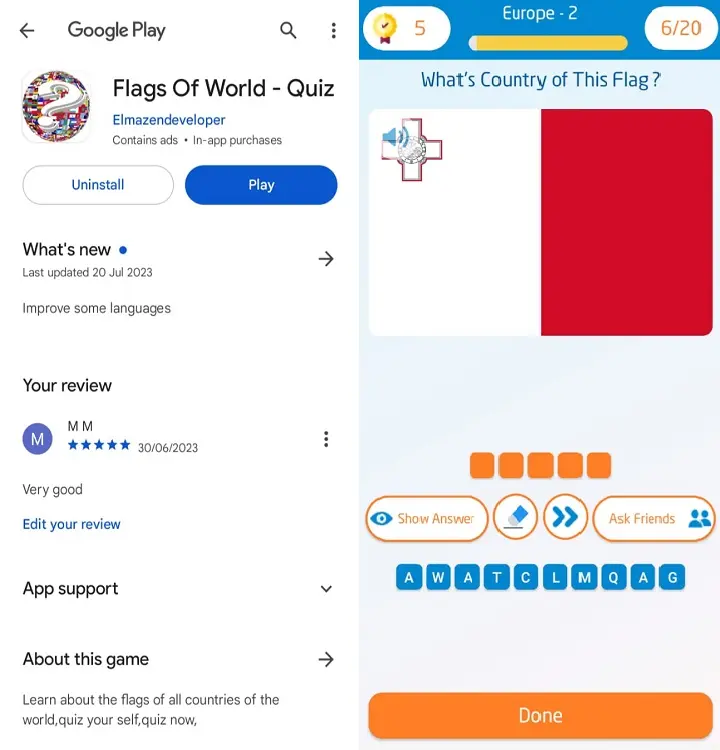
Download the application  Flags Of World - Quiz ,
Flags Of World - Quiz ,
And test your knowledge with Flags of World ,
1. Population of Malta :
As of December 2024, Malta has a population of approximately 542,000 people.
The population density is quite high due to its small land area of just 316 square kilometers, making it one of the most densely populated countries in Europe.
The majority of the population resides in urban areas, particularly around the capital, Valletta, and other coastal towns.
2. Meaning of Malta's Flag :
The flag of Malta consists of two vertical stripes, one white (on the left) and one red (on the right).
In the top left corner of the white stripe, there is a representation of the George Cross, outlined in red.
The flag’s colors have deep historical significance, with white and red believed to trace back to the colors of the Norman rulers who governed Malta during the medieval period.
The George Cross, awarded to the Maltese people by King George VI in 1942, recognizes the bravery and courage shown by the island’s inhabitants during World War II, particularly during the relentless bombardments they endured.
3. Malta's Currency :
Malta uses the Euro (€) as its official currency, having adopted it on January 1, 2008. Before this, the Maltese lira (MTL) was the national currency.
As part of the European Union since 2004, Malta transitioned to the Euro smoothly, making it convenient for trade, tourism, and business interactions with other EU nations.
Flag of Malta, Currency, Population, Tourist Places

Download the application  Flags Of World - Quiz ,
Flags Of World - Quiz ,
And test your knowledge with Flags of World ,
4. Malta's Borders :
Malta is an island country, so it does not share land borders with any other country.
It is located in the central Mediterranean Sea, about 93 kilometers (58 miles) south of Sicily (Italy) and roughly 300 kilometers (186 miles) north of the African continent.
Its position has made it a strategic naval and trading point for centuries, influencing its history and culture through interactions with various civilizations.
5. Culture of Malta :
Malta's culture is a melting pot of influences from its long history under different rulers, including the Phoenicians, Romans, Arabs, Normans, the Knights of St. John, French, and the British.
The Maltese people are predominantly Roman Catholic, and the religion plays a significant role in the country’s traditions, festivals, and daily life.
The Maltese language, a Semitic language with heavy influences from Italian and English, is a vital part of the culture.
English is also widely spoken and is one of the official languages, along with Maltese.
Cultural highlights include the vibrant village festivals (known as "festas"), which celebrate the patron saints with parades, fireworks, and music.
Maltese cuisine also reflects its diverse influences, with dishes like rabbit stew, pastizzi (flaky pastry filled with ricotta or peas), and seafood playing a major role in local cuisine.
6. Best Places to Visit in Malta :
Malta offers a variety of attractions for visitors, from historical landmarks to natural beauty.
Here are some of the best places to visit:
Valletta :
The capital city of Malta is a UNESCO World Heritage Site known for its 16th-century architecture, fortifications, and cultural landmarks, including St.
John’s Co-Cathedral, the Grandmaster’s Palace, and the Upper Barrakka Gardens.
Mdina :
Known as the "Silent City," Mdina is a beautifully preserved medieval town with narrow streets, ancient buildings, and an incredible view of the island from its fortifications.
The Blue Lagoon (Comino Island) :
This stunning lagoon is known for its crystal-clear turquoise waters, perfect for swimming, snorkeling, and relaxing.
Gozo Island :
Malta’s sister island, Gozo, is less urbanized and offers a more tranquil experience with its rugged coastline, historical sites like the Ġgantija Temples, and natural beauty such as the Inland Sea.
The Hypogeum of Ħal-Saflieni :
A unique UNESCO World Heritage Site, this underground prehistoric burial site is a must-see for history enthusiasts, with its intricate carvings and well-preserved chambers dating back thousands of years.
Marsaxlokk :
A traditional fishing village famous for its colorful boats (luzzus) and vibrant Sunday fish market, offering a glimpse into Malta’s maritime heritage.
Hagar Qim and Mnajdra Temples :
These ancient megalithic temples are among the oldest free-standing structures in the world, predating even Stonehenge and the Pyramids of Giza.
Conclusion :
Malta may be small in size, but it is brimming with history, culture, and natural beauty.
From its dense population to its rich heritage reflected in the flag, language, and traditions, Malta has something to offer everyone.
Whether you’re exploring its historic cities, relaxing on its beautiful beaches, or diving into its vibrant culture, Malta is a destination that captivates and delights.
Flag of Malta, Currency, Population, Tourist Places

Download the application  Flags Of World - Quiz ,
Flags Of World - Quiz ,
And test your knowledge with Flags of World ,
- Details
- Written by: Elmazen
- Category: Flags of Countries of the World
- Hits: 825
Flag of Luxembourg, Currency, Population, Tourist Places, Borders, Culture
Discover Luxembourg: A Charming European Gem
Luxembourg is a small yet fascinating country located in Western Europe, rich in history, culture, and scenic beauty.
While often overshadowed by its larger neighbors, Luxembourg stands out for its high quality of life, multicultural society, and beautiful landscapes.
Let’s dive into some key aspects of this unique nation.
Flag of Luxembourg, Currency, Population, Tourist Places
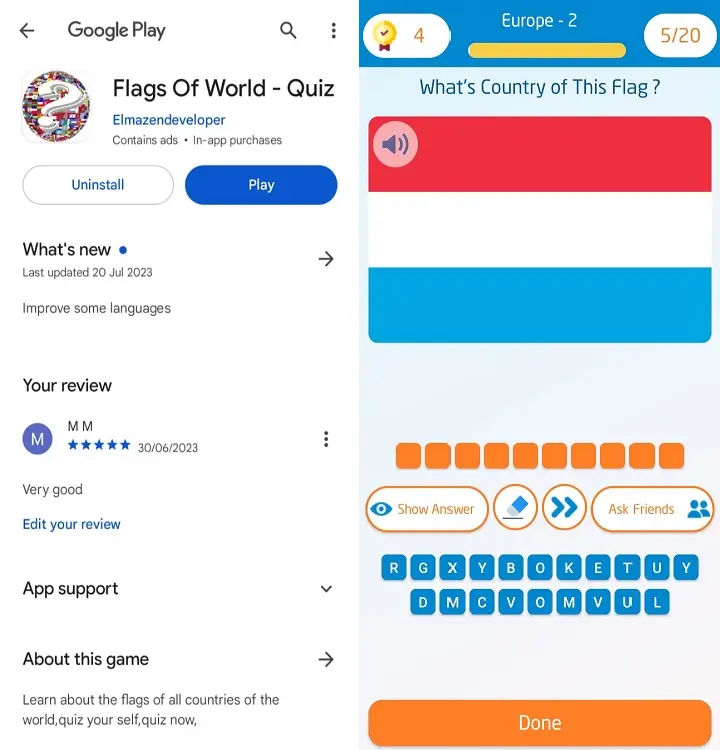
Download the application  Flags Of World - Quiz ,
Flags Of World - Quiz ,
And test your knowledge with Flags of World ,
1. Population of Luxembourg :
Luxembourg’s population is relatively small, making it one of Europe’s least populous countries.
As of December 2024, the population is estimated at around 676,000 people.
Despite its modest size, Luxembourg is incredibly diverse.
About half of its residents are foreigners, primarily from other European countries like Portugal, France, Belgium, and Germany.
This blend of cultures gives the country a cosmopolitan feel, with many languages commonly spoken, including Luxembourgish, French, and German.
2. Luxembourg Country Flag Meaning :
Luxembourg’s flag consists of three horizontal stripes of red, white, and light blue.
Though it might resemble the flag of the Netherlands, the colors and proportions are distinct.
The flag’s colors date back to the 13th century and symbolize important aspects of Luxembourg’s history:
- Red represents the blood shed in Luxembourg's struggle for independence.
- White symbolizes peace and harmony.
- Light Blue reflects the country’s independence and its unique identity.
The flag has been in official use since 1972 and is a source of national pride.
3. Luxembourg Country Currency :
The official currency of Luxembourg is the Euro (€), which it has used since 1999 when the Eurozone was created.
Before adopting the euro, Luxembourg used the Luxembourgish franc, but the country transitioned smoothly to the euro, reflecting its strong ties to the European Union.
Flag of Luxembourg, Currency, Population, Tourist Places

Download the application  Flags Of World - Quiz ,
Flags Of World - Quiz ,
And test your knowledge with Flags of World ,
4. Luxembourg Country Borders :
Luxembourg is a landlocked country, sharing borders with three nations:
- Belgium : to the west and north,
- Germany : to the east, and
- France : to the south.
Despite its small size (2,586 square kilometers or 998 square miles), Luxembourg’s location makes it an important hub for European travel and commerce.
Its borders reflect the country’s close historical and economic ties with its neighbors.
5. Culture of Luxembourg :
Luxembourg has a rich and diverse culture, influenced by its history and position at the crossroads of Germanic and Latin Europe.
The country has three official languages-Luxembourgish, French, and German-which reflects the multicultural nature of daily life.
Luxembourg’s traditions and customs are a blend of these influences, creating a unique cultural identity.
- Festivals and Celebrations : Luxembourg is home to various cultural festivals.
One of the most popular is the Schueberfouer, an annual funfair held in late summer, dating back to the 14th century.
The National Day on June 23 is also widely celebrated with fireworks, parades, and public gatherings.
- Cuisine : Luxembourgish cuisine is influenced by both French and German traditions, with hearty dishes such as Judd mat Gaardebounen (smoked pork with broad beans) and Bouneschlupp (green bean soup) being local favorites.
Wine from the Moselle Valley and beer also play a significant role in Luxembourg’s culinary culture.
- Music and Arts : The country has a vibrant arts scene with institutions like the Philharmonie Luxembourg and Mudam Luxembourg (the contemporary art museum) offering world-class performances and exhibitions.
6. Best Places to Visit in Luxembourg :
Though small, Luxembourg offers plenty of beautiful and historically significant places to visit:
Luxembourg City :
The capital city is renowned for its stunning mix of modern architecture and historical fortifications.
The Old Town, a UNESCO World Heritage site, features narrow streets, historic buildings, and breathtaking views of the Alzette River valley.
Vianden Castle :
One of the most beautiful castles in Europe, Vianden Castle sits on a hill overlooking the town of Vianden.
It dates back to the Romanesque and Gothic periods and is a must-see for history lovers.
Echternach :
Known for its medieval abbey and quaint old town, Echternach is Luxembourg’s oldest city.
The Basilica of St. Willibrord and the annual Echternach Dancing Procession make it a cultural hub.
Müllerthal Region (Little Switzerland) :
This region is famous for its lush forests, dramatic rock formations, and hiking trails.
Nature lovers will appreciate the serene beauty and opportunities for outdoor activities.
Clervaux :
A picturesque town with a beautiful castle, Clervaux is home to the Family of Man photo exhibition, curated by famed photographer Edward Steichen.
It’s a UNESCO-listed collection of photographs promoting peace and equality.
Moselle Valley :
This region is known for its scenic vineyards and excellent wines.
A visit to the Moselle Wine Route offers a chance to sample local wines and enjoy the riverside beauty.
Conclusion :
Luxembourg may be small in size, but it is rich in history, culture, and natural beauty.
From its diverse population to its picturesque landscapes, the country offers visitors and residents alike a blend of modernity and tradition.
Whether you're wandering through Luxembourg City’s historic streets, exploring the beautiful castles, or enjoying a glass of wine by the Moselle, Luxembourg has something for everyone to enjoy.
Flag of Luxembourg, Currency, Population, Tourist Places

Download the application  Flags Of World - Quiz ,
Flags Of World - Quiz ,
And test your knowledge with Flags of World ,
- Details
- Written by: Elmazen
- Category: Flags of Countries of the World
- Hits: 801
Flag of Lithuania, Currency, Population, Tourist Places, Borders, Best Places
An Overview of Lithuania
Lithuania is a small but historically rich and culturally vibrant country located in the Baltic region of Europe.
Its blend of medieval heritage, natural beauty, and modern progressiveness has made it a fascinating destination for travelers.
Below is a detailed exploration of Lithuania, covering its population, flag, currency, borders, culture, and top places to visit.
Flag of Lithuania, Currency, Population, Tourist Places
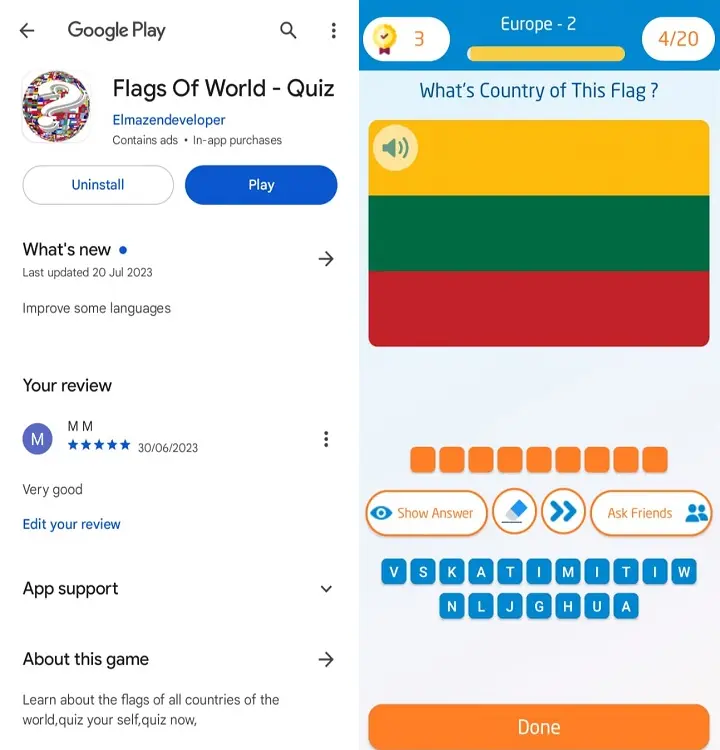
Download the application  Flags Of World - Quiz ,
Flags Of World - Quiz ,
And test your knowledge with Flags of World ,
1. Population of Lithuania :
Lithuania has a population of approximately 2.84 million people as of December 2024.
Over the past few decades, the country has seen a decline in population due to factors such as emigration and a lower birth rate.
However, the capital city, Vilnius, remains the largest urban center and continues to grow as a hub of culture, business, and education.
2. Lithuania’s Flag Meaning :
The Lithuanian flag consists of three horizontal stripes: yellow on top, green in the middle, and red at the bottom.
Each color holds significant symbolism:
- Yellow : represents the country’s prosperity, the sun, and freedom.
- Green : symbolizes Lithuania’s forests, nature, and agricultural tradition.
- Red : signifies the blood shed by the country's people in their fight for independence and their love for the homeland.
Adopted officially on March 20, 1989, this tricolor reflects Lithuania’s journey through history, emphasizing its natural beauty, hard-fought independence, and resilience.
3. Lithuania’s Currency :
Lithuania's currency is the Euro (€), which it adopted on January 1, 2015, replacing the former currency, the Lithuanian litas (LTL).
As part of the European Union since 2004, Lithuania's switch to the euro helped integrate its economy more closely with Europe.
The move has facilitated easier trade and travel within the Eurozone and contributed to economic stability.
Flag of Lithuania, Currency, Population, Tourist Places

Download the application  Flags Of World - Quiz ,
Flags Of World - Quiz ,
And test your knowledge with Flags of World ,
4. Lithuania’s Borders :
Lithuania shares borders with four countries:
- Latvia : to the north,
- Belarus : to the east and southeast,
- Poland : to the south,
- Russia : to the west, specifically with the Kaliningrad Oblast, an exclave of Russia.
To the west, Lithuania also has a coastline along the Baltic Sea, giving it access to maritime trade and tourism.
5. Culture of Lithuania :
Lithuania's culture is a blend of ancient traditions, modern European influences, and a deep connection to nature.
Here are a few aspects of Lithuanian culture:
- Language : Lithuanian is one of the oldest languages in the world, belonging to the Baltic language group and known for its preservation of many archaic features.
- Music and Dance : Folk music and traditional dances play a vital role in cultural festivals, with the Dainų šventė (Song Festival) being a UNESCO-listed event that showcases Lithuanian singing and folk traditions.
- Religion : Lithuania is predominantly Roman Catholic, with over 75% of its population identifying with the religion.
Churches and cathedrals are key landmarks in cities and towns, especially in Vilnius, which is known for its baroque architecture.
- Crafts and Art : Lithuania has a strong tradition of handicrafts, including woodworking, pottery, and textile arts such as weaving.
The national symbol, the Iron Wolf, also has deep mythological roots.
Lithuanians value their history and freedom, having gone through significant political and social changes, including occupation during World War II and subsequent independence from the Soviet Union in 1990.
6. Best Places to Visit in Lithuania :
Lithuania offers a variety of destinations for tourists, from medieval castles to pristine nature reserves.
Here are some of the top places to visit:
Vilnius :
The capital is renowned for its charming Old Town, a UNESCO World Heritage Site filled with baroque churches, narrow streets, and vibrant cafés.
Don’t miss the Gates of Dawn, the Cathedral Square, and the artistic neighborhood of Uzupis.
Trakai Island Castle :
Situated on an island in Lake Galvė, this picturesque 14th-century castle is a symbol of Lithuania's medieval history.
Visitors can explore the castle museum and enjoy the serene surroundings.
Curonian Spit National Park :
A UNESCO World Heritage Site, this thin stretch of land between the Curonian Lagoon and the Baltic Sea is famous for its towering sand dunes, dense forests, and unique flora and fauna.
Hill of Crosses :
Located near the city of Šiauliai, this pilgrimage site features thousands of crosses left by visitors over the centuries.
It is a symbol of Lithuania’s enduring faith and resistance.
Kaunas :
Lithuania’s second-largest city, Kaunas boasts a well-preserved Old Town, lively markets, and impressive interwar architecture.
The Ninth Fort is a poignant reminder of the country's turbulent past.
Druskininkai :
A famous spa town known for its mineral springs and wellness centers, Druskininkai is a perfect destination for relaxation and nature retreats.
Conclusion :
Lithuania is a country with a rich cultural heritage, stunning natural landscapes, and an inspiring history of perseverance.
From its symbolic flag and thriving traditions to its welcoming people and beautiful destinations, Lithuania is a place that continues to capture the hearts of both locals and visitors alike.
Whether you're interested in its historical sites, outdoor adventures, or vibrant cities, Lithuania offers a variety of experiences to explore.
Flag of Lithuania, Currency, Population, Tourist Places
